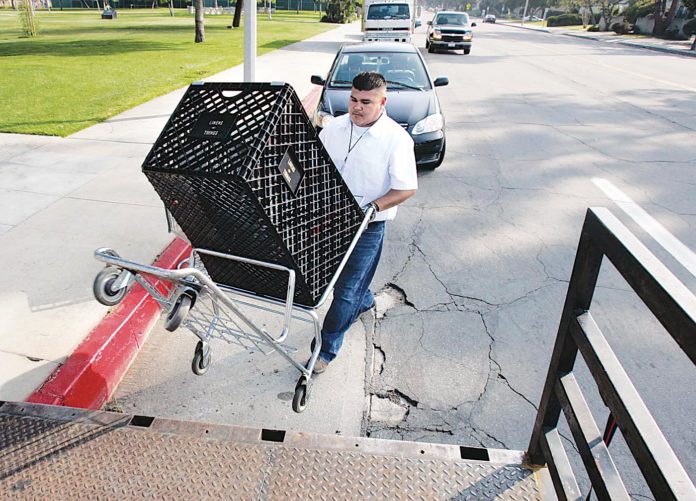Local grocery chains fear that last week’s move by the Los Angeles City Council to force new supermarkets and grocery stores to keep shopping carts on their premises is just the beginning of a costly crackdown.
Citing safety hazards and blight created by abandoned shopping carts on streets and sidewalks, the City Council last week voted unanimously to direct staff to craft an ordinance requiring new and remodeled grocery stores to install cart containment systems. The measures could include costly electronic equipment and wheel-lock systems or hiring extra security guards.
But the council also directed administrators to look into the feasibility of applying the ordinance to existing grocery stores. That has the industry concerned that all stores – even ones that don’t have stray shopping carts – will have to spend a good deal of money to corral their carts.
“Our major concern is that even grocery stores that don’t have a problem with abandoned shopping carts are going to have to spend tens of thousands of dollars just to comply,” said Matthew Dodson, director of local government relations for the California Grocers Association.
Dodson and the grocery industry lobbied Councilman Tony Cardenas, the architect of the shopping cart proposal, to exempt most existing grocery stores from the proposed ordinance.
Other cities already have laws on their books requiring grocery stores to have containment systems for their shopping carts. For example, since 2006, Glendale has required all grocery operators to have cart containment systems that allow fewer than five carts per day off the store and parking lot premises.
Under Cardenas’ proposed ordinance for Los Angeles, grocery stores covered by the ordinance can choose from a menu of containment options, including installation of wheel-locking devices on shopping carts that are activated when the cart moves off the premises, physical barriers around supermarket parking lots or the hiring of additional security guards. Stores that do not adopt containment systems would be fined.
Dodson said that installing wheel-locking devices on shopping carts costs about $100 per shopping cart, plus about $20,000 to $30,000 for a sensor system embedded in the pavement at the perimeter of the parking lot.
Abandoned carts
Shopping carts are often taken off grocery store premises by patrons without cars who carry their groceries home on foot. Once they arrive home and unload the groceries, they leave the shopping carts on sidewalks or in apartment complexes.
A six-month pilot program two years ago in Cardenas’ San Fernando Valley district resulted in the collection of 6,800 abandoned shopping carts. According to Cardenas, one retailer had 900 carts – valued at up to $100 each – returned to them.
“This is more than just a nuisance or eyesore,” Cardenas said. “This is about public safety. If over 6,800 carts were found in my district alone, imagine how many carts are out there citywide sitting in the streets as a primer for catastrophic accidents. My office even witnessed kids playing on carts in the middle of the street and rolling directly into traffic.”
Many grocery chains contract with private services that collect shopping carts from their neighborhoods, load them on pickup trucks and return them to the store.
But the shopping cart containment proposal approved by the council last week also includes a provision that would impose a fee on all grocery stores to fund a program where city workers would round up stray shopping carts. The amount of the fee wasn’t specified.
Dodson said the grocery store industry is opposed to such a fee.
“It would penalize the stores that already have their own shopping cart collection programs, forcing them essentially to pay twice,” he said.
A better solution, he said, would be to require all grocery stores to either contract with a service or round up stray shopping carts themselves and only impose fines on those stores without such a program.
As for customers who now bring their groceries home in carts, Glendale’s city website recommends they purchase “personal shopping carts”; these collapsible carts range from $15 to $35.

